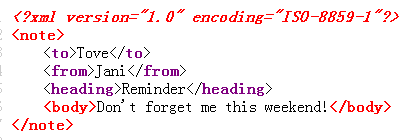PHP XML DOM
The built-in DOM parser makes it possible to process XML documents in PHP.
What is DOM?
W3C DOM provides a standard set of objects for HTML and XML documents, as well as a standard interface for accessing and manipulating these documents.
W3C DOM is divided into different parts (Core, XML and HTML) and different levels (DOM Level 1/2/3):
* Core DOM - Defines a standard set of objects for any structured document
* XML DOM - For XML Documents define a standard set of objects
* HTML DOM - Define a standard set of objects for HTML documents
To learn more For knowledge about XML DOM, please visit our XML DOM tutorial.
XML Parsing
To read and update - create and process - an XML document, you need XML parser.
There are two basic types of XML parsers:
· Tree-based parser: This parser converts the XML document into a tree structure. It analyzes the entire document and provides access to elements in the tree, such as the Document Object Model (DOM).
· Time-based parser: Treat XML documents as a series of events. When a specific event occurs, the parser calls a function to handle it.
The DOM parser is a tree-based parser.
Please see the following XML document fragment:
##XML DOM Treat the above XML as A tree structure: · Level 1: XML document· Level 2: Root element: <from>· Level 3: Text element: "Jani"<?xml version="1.0" encoding="ISO-8859-1" ?>
<from>Jani</from>
Installation
The DOM XML parser function is an integral part of the PHP core. No installation is required to use these functions.XML file
The following xml_dom.xml file will be used in our example:<?xml version="1.0" encoding="ISO-8859-1"?> <note> <to>Tove</to> <from>Jani</from> <heading>Reminder</heading> <body>Don't forget me this weekend!</body> </note>
Loading and outputting XML
We need to initialize the XML parser, load the XML, and output it:Example
<?php
$xmlDoc = new DOMDocument();
$xmlDoc->load("xml_dom.xml");
print $xmlDoc->saveXML();
?>The above code will output:
ToveJaniReminderDon't forget me this weekend!
If you view the source code in a browser window, you will see the following HTML:

The above example creates a DOMDocument-Object and loads the XML in "xml_dom.xml" into this document object.
The saveXML() function puts the internal XML document into a string so we can output it.
##Traversing XML
We need to initialize the XML parser, load the XML, and iterate through all elements of the <note> element:<?php
$xmlDoc = new DOMDocument();
$xmlDoc->load("xml_dom.xml");
$x = $xmlDoc->documentElement;
foreach ($x->childNodes AS $item)
{
print $item->nodeName . " = " . $item->nodeValue . "<br>";
}
?>The above code will output: In the example above, you see that there are empty text nodes between each element . When XML is generated, it will usually contain whitespace between nodes. The XML DOM parser treats them as normal elements, which can sometimes cause problems if you don't pay attention to them.#text = to = Tove
#text =
from = Jani
#text =
heading = Reminder
#text =
body = Don't forget me this weekend!
#text =
To learn more about XML DOM, visit our XML DOM tutorial.
